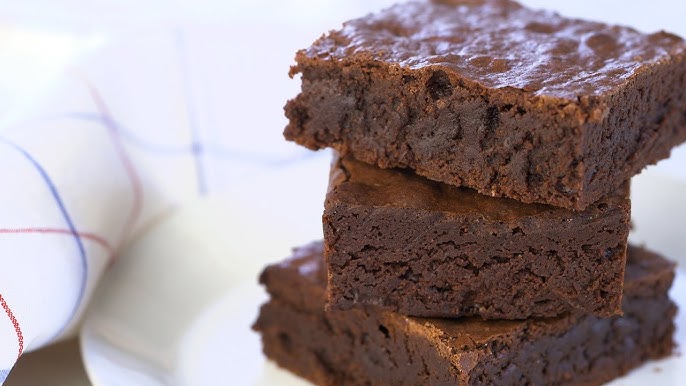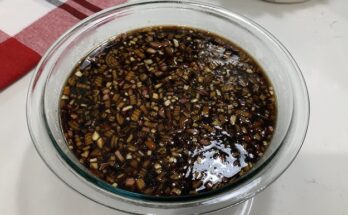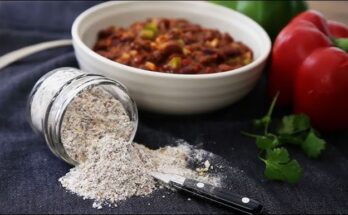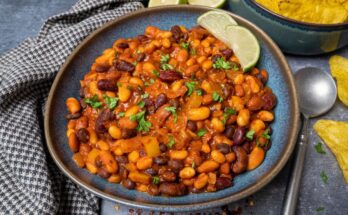Chewy Brownie Recipe: Brownies come in many styles—cakey, fudgy, gooey—but there’s something magical about a chewy brownie. That irresistible texture, the slight resistance as you bite through the crust, and the soft center that melts in your mouth—it’s a chocolate lover’s dream come true. But what exactly makes a brownie chewy instead of cakey or fudgy?
The answer lies in the balance of ingredients and baking method. Chewy brownies are defined by their dense yet tender crumb and a richness that’s never too overwhelming. The perfect chewy brownie has just the right amount of sugar to create a delicate crust, a generous helping of butter and eggs for structure and moisture, and a careful mix of flour and cocoa to ensure it holds together without becoming dry.
People love chewy brownies because they strike the perfect balance. Not too dry like cakey ones, and not overly dense like some fudgy versions, they offer the best of both worlds. In this guide, you’ll find everything you need to whip up a batch of ultra-chewy, chocolate-packed brownies from scratch. Let’s dive into the recipe, and by the end, you’ll be the go-to brownie expert in your home.
Ingredients for Chewy Brownies
Essential Dry Ingredients
To get that iconic chewy texture, it’s crucial to start with the right dry ingredients:
- All-purpose flour: This is your base. Use just enough to provide structure, but not so much that the brownies become cakey.
- Unsweetened cocoa powder: Use a high-quality cocoa powder for deep chocolate flavor. Dutch-processed or natural cocoa both work, but they yield slightly different flavors.
- Salt: Enhances the chocolate flavor and balances the sweetness.
- Baking powder (optional): A small amount can lighten the texture slightly, but it’s not essential for chewy brownies.
The key here is ratio. Too much flour, and you’ll get cake. Too little, and the brownies won’t set. Just one cup of flour is often all you need for a dense, chewy batch.
Wet Ingredients for Moistness
Chewy brownies rely heavily on the balance of fats and liquids:
- Melted butter: Butter adds flavor and fat, both of which are crucial for chewiness. Melting it gives you a dense texture as opposed to creaming.
- Granulated sugar and brown sugar: A mix of both sugars adds sweetness and contributes to the chewy crust and tender interior. Brown sugar’s molasses content helps retain moisture.
- Eggs: Provide structure and richness. Using whole eggs ensures the brownies hold together without being dry.
- Vanilla extract: A dash of vanilla brings out the chocolate notes and rounds out the flavor.
The secret weapon in chewy brownie batter is that combination of melted butter and sugar—it forms a glossy, almost caramel-like base that locks in the chewiness once baked.
Optional Mix-ins for Texture and Flavor
Want to take your chewy brownies to the next level? Try these optional add-ins:
- Chocolate chips or chunks: Stir them into the batter for gooey pockets of melted chocolate.
- Nuts (walnuts, pecans): Add crunch and contrast to the soft, chewy base.
- Espresso powder: Intensifies the chocolate flavor without making it taste like coffee.
- Sea salt flakes: Sprinkle on top before baking for a gourmet touch.
With the base nailed down, you can get creative while still keeping that signature chewy bite.
Tools and Equipment Needed
Baking Tools You’ll Need
Even the best ingredients won’t deliver great results without the right tools. Here’s what you’ll need:
- Mixing bowls: Preferably glass or stainless steel for easy mixing and melting.
- Whisk and spatula: A whisk for combining wet ingredients, and a spatula for folding in dry ones.
- Measuring cups and spoons: Precision matters in baking—don’t eyeball!
- Microwave-safe bowl or double boiler: For melting butter and chocolate.
- Oven thermometer: Ensures your oven is at the right temperature, since most home ovens can be off by 10–15 degrees.
Choosing the Right Baking Pan
Believe it or not, your choice of baking pan has a big impact on the texture of your brownies.
- Size: A standard 8×8 or 9×9 inch square pan is perfect for thick, chewy brownies.
- Material: Metal pans conduct heat better and produce crispier edges, while glass pans can bake more evenly but take longer to heat.
- Lining: Always line your pan with parchment paper. It makes removing and slicing brownies easier and keeps them from overbaking on the bottom.
- Avoid overfilling the pan. A thinner layer of batter can overbake quickly and lose its chewiness. Aim for about ¾-inch thickness before baking.
Step-by-Step Instructions for Making Chewy Brownies
Step 1: Preparing Your Ingredients and Pan
Preparation is key to stress-free baking. Before you start mixing, gather all your ingredients and tools. Preheat your oven to 350°F (175°C). If your oven runs hot or cool, adjust accordingly with an oven thermometer.
Line an 8×8 or 9×9 inch square baking pan with parchment paper, leaving some overhang on the sides. This makes lifting out the brownies easy once they’re baked and cooled. Lightly spray or butter the paper to prevent sticking.
Next, measure out all your ingredients accurately. Use the scoop-and-level method for flour and cocoa—scooping directly from the bag can lead to packing and too much flour. Crack your eggs into a separate bowl to check for shells before adding to the batter.
Getting everything ready ahead of time (a method chefs call mise en place) ensures a smooth and quick process once the butter is melted and things move fast. Organization also reduces the chance of missing any critical ingredient like eggs or sugar.
Step 2: Melting the Butter and Chocolate
This is where the rich, gooey magic starts. In a microwave-safe bowl or double boiler, melt 1 cup (2 sticks) of unsalted butter with ¾ cup of chocolate chips or chopped dark chocolate. Microwave in 30-second bursts, stirring between each, until completely smooth and glossy.
Let it cool for about 5 minutes. You want it warm, not hot—hot butter can scramble your eggs and ruin the texture. Once cooled slightly, whisk in 1 cup of granulated sugar and ½ cup of brown sugar until well blended. The sugars will help create that iconic crackly top and contribute to chewiness.
Then, add 2 large eggs one at a time, whisking vigorously after each. Follow with 1 teaspoon of vanilla extract. Whisk until the batter is smooth and glossy—it should look thick and rich.
Step 3: Mixing the Dry Ingredients
In a separate bowl, sift together:
- 1 cup all-purpose flour
- ¾ cup unsweetened cocoa powder
- ½ teaspoon salt
- (Optional) ¼ teaspoon baking powder
Sifting helps break up any clumps and ensures even distribution. If you’re using Dutch-process cocoa, the color will be darker and the flavor deeper. Mix with a whisk or fork until everything is evenly combined.
Now, slowly add the dry ingredients to the wet mixture. Use a rubber spatula or wooden spoon to fold, not whisk. Folding helps keep air out of the batter and maintains that dense, chewy texture we’re aiming for.
Mix just until the flour is incorporated. Overmixing can activate the gluten and make the brownies tough—definitely not what we want.
Step 4: Combining Wet and Dry Ingredients
This is where everything comes together. If you’re adding mix-ins like chocolate chunks, nuts, or espresso powder, now’s the time to stir them in. Limit mix-ins to about 1 cup total to avoid overwhelming the base batter.
Scrape the batter into your prepared pan, spreading it evenly to the corners. The batter will be thick and rich—almost like frosting. Use your spatula to smooth the top.
Tap the pan gently on the counter to remove any air bubbles. For an extra pro touch, sprinkle sea salt flakes or a few extra chocolate chips on top before baking.
Step 5: Baking to Perfection
Slide the pan into your preheated oven and bake for 28 to 35 minutes, depending on your oven and pan. Start checking at the 28-minute mark.
To test for doneness, insert a toothpick in the center. It should come out with moist crumbs—not raw batter, and not completely clean. That’s your sign they’re perfectly chewy. Overbaking is the biggest enemy of chewy brownies.
Once done, remove from the oven and let cool in the pan for at least 30 minutes. This helps them set and makes slicing easier.
After cooling, use the parchment overhang to lift the brownies out of the pan. Cut with a warm, clean knife for perfect edges every time.
Tips for the Perfect Chewy Brownie Texture
What to Avoid for Chewy Consistency
The chewy magic can be ruined by simple mistakes:
- Don’t overbake: This dries out the brownies and makes them crumbly.
- Avoid too much flour: Extra flour makes them cakey.
- Skip creaming butter and sugar: That introduces air and leads to a lighter, fluffier texture—not chewy.
- Don’t overmix: Especially once the flour is added.
Chewiness comes from moisture retention, low flour content, and a good balance of sugar and fat. Stick to the ratios and method, and you’re golden.
Ingredient Substitutions That Still Keep It Chewy
Need to make some swaps? Here are options that won’t mess up the texture:
- Butter: Can be replaced with equal parts melted coconut oil or margarine, though the flavor will shift slightly.
- Eggs: For a vegan version, try flax eggs (1 tbsp flaxseed meal + 2.5 tbsp water per egg).
- Sugar: A mix of coconut sugar and maple syrup can substitute, but reduce the liquid slightly.
- Flour: Use a 1:1 gluten-free flour blend for GF brownies. Almond flour makes them fudgier but still chewy.
Always test small batches when swapping ingredients. Chewy perfection can handle a little variation but thrives in balance.
Storing and Serving Suggestions
How to Store Brownies for Freshness
You’ve baked the perfect chewy brownies—now how do you keep them fresh and delicious for days? Storage is more than just tossing them in a container. Here’s how to keep them chewy, not dry or soggy:
- Room Temperature: Store brownies in an airtight container at room temperature for up to 4 days. Use parchment paper between layers to prevent sticking.
- Fridge Storage: If your kitchen is warm or humid, store them in the refrigerator. They’ll last up to a week, though the texture becomes firmer. Bring to room temp before eating to soften.
- Freezing: Want to save some for later? Brownies freeze wonderfully. Wrap individual squares tightly in plastic wrap, then place in a freezer-safe bag or container. Freeze for up to 3 months.
- Thawing: To thaw, leave brownies at room temperature for a few hours or warm them in the microwave for 15–20 seconds for that fresh-baked feel.
Proper storage keeps those edges crisp and centers perfectly chewy. Pro tip: don’t slice the entire pan at once—cut only what you need to retain maximum moisture.
Creative Serving Ideas
Sure, brownies are awesome on their own—but let’s talk glow-up. Here are fun, tasty ways to serve your chewy brownies:
- Warm with Ice Cream: Classic combo. Heat a brownie and top with vanilla or salted caramel ice cream. Drizzle with hot fudge or caramel sauce.
- Brownie Sundae Bar: Hosting a party? Make a DIY brownie sundae bar with toppings like whipped cream, nuts, fruits, syrups, and sprinkles.
- Brownie Trifles: Layer brownie chunks with whipped cream and berries in a jar for a cute dessert.
- Brownie Ice Cream Sandwiches: Slice thin brownies, fill with ice cream, and freeze. Decadent and refreshing.
- Brownie Pops: Insert sticks into brownie squares, dip in melted chocolate, and decorate with sprinkles for a fun, portable treat.
These serving twists make your chewy brownies the star of any gathering—or a fancy treat just for yourself!
FAQs about Chewy Brownie Recipe
Q1: How do I make my brownies more chewy than cakey?
To get that signature chew, use more brown sugar than white sugar, and reduce the flour slightly. Also, avoid overmixing—stir just until combined.
Q2: Can I use melted butter instead of oil?
Yes! Melted butter adds a rich flavor and helps with that chewy texture. Just be sure to cool it slightly before mixing with the eggs.
Q3: Why did my brownies turn out dry?
Overbaking is the usual culprit. Check your brownies 5 minutes before the timer goes off. A toothpick should come out with moist crumbs, not clean.
Q4: Can I add nuts or chocolate chips?
Absolutely. Walnuts, pecans, or dark chocolate chips add great texture and depth of flavor. Fold them in gently right before baking.
Q5: How should I store chewy brownies?
Store them in an airtight container at room temperature for up to 3 days. For longer storage, freeze them with parchment between layers.
Q6: Do chewy brownies need to cool completely before cutting?
Yes—cool for at least 1 hour. This helps them set properly and makes cutting cleaner, especially if you want those perfect square edges.
Conclusion
Chewy brownies are the kind of comfort dessert that never goes out of style. They’re rich, chocolatey, and have that satisfying texture you just can’t resist. With this step-by-step guide, you’ve got all the tools and tips to bake the best chewy brownies right in your kitchen—no boxed mix needed.
From understanding the key ingredients and mastering the bake time to storing them just right and serving with flair, you now know how to create a batch of brownies that checks all the boxes: chewy, chocolaty, and downright addictive.
So next time you’re craving something sweet, skip the bakery and whip up these homemade chewy brownies instead. Trust me, your friends and family (if you decide to share) will be begging for the recipe.



